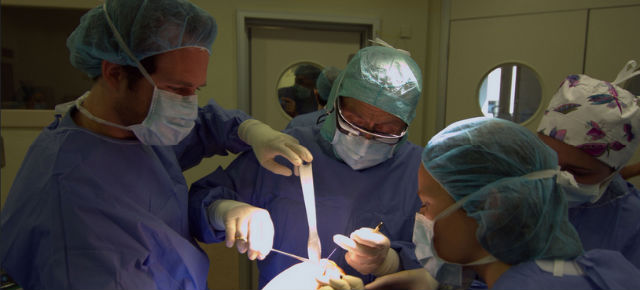Google Glass might get you suspicious looks in a restaurant, but it could save your life on the operating table. In hospitals and medical facilities, Google’s techno-eyewear is a promising solution — with a caveat.
Google has a lot of work to do to make Glass something we want to wear. It’s pricey. It’s dorky as shit. The privacy implications freak people out, with good reason. But there’s one place where Glass is already ready to go: telemedicine.
Glass can help doctors consult patient records while they continue to work. The lightweight design and hands-free messaging and recording makes it easy to teleconference during surgery, when having both hands available is crucial and older existing tech is more cumbersome and expensive.
This is why the emergency department at Beth Israel Hospital has started wearing Glass. And why doctors at Duke Medical Center have scrubbed in with it as well. It’s why big tech companies like Philips are developing Glass projects for doctors. A paediatric doctor recently published a peer-reviewed article extolling the virtues of Glass in a medical setting, with the caveat that issues of data protection are still a problem.
They Might Want to Add “Don’t Be a Glasshole” to the Hippocratic Oath
At this point you might be thinking that mounting face cameras on doctors who often see you naked or compromised is troubling. That is a very reasonable concern, one that I share. When I was looking into Glass as a medical tool, I thought it would be shady as hell. Who wants their medical data on Google’s servers? Who wants their doctor asking them to get undressed to check out a lower back mole with Glass on, possibly broadcasting the mole and your buttcrack to some ring of mole fetishists? It’s not like doctors are saints. They, like all other humans, are not automatically trustworthy.
For those reasons, Google Glass out of the box is not appropriate for doctors, even if they pinkie-swear not to livestream your colonoscopy on YouTube.
Making Glass Hospital-Safe
Glass needs to be modified to make sense as a medical tool. It absolutely needs to be disconnected from Google’s servers, so medical data is not stored by the tech company. That’s one of the modifications telemedicine company Pristine makes when it send out its doctor-ready version of Glass. Pristine’s Eyewear and Checklist apps aid doctors but keep the information behind a hospital’s firewall.
“In healthcare technology there’s HIPAA, the privacy and security guideline for health IT. And that’s really where we differentiate ourselves,” Pristine spokesman Lucas Schlager told me. “What we’ve done, because we’re optimising for healthcare environments, we’ve made the only HIPAA-compliant video solution for Glass. It’s fully encrypted, it’s fully secure, and it’s really dedicated for healthcare use,” he said.
Rhode Island Hospital decided to partner with Pristine for a six-month trial for using Glass in an emergency setting, testing how it worked when a dermatologist consultant helped examine patients via Glass, and Brown University and UC-Irvine are also Pristine clients.
Making Sure Glass Doesn’t Scare Patients
I asked how Pristine deals with patient concerns that, you know, Glass is creepy.
“We kind of joke that, as part of our process, we take the Google out of the Glass. Because a lot of patient concern comes from that you’re wearing this camera on your face that has Google on it. It has YouTube on it, it has Google+, those surgery pictures are going up on the internet! So part of our process is removing all that Google software. You don’t need YouTube in the hospital. We create a very locked-down version of software,” Schlager told me.
The locked-down version of Glass still allows doctors to teleconference, using a program called EyeSight. It lets doctors consult specialists or demonstrate something to medical students, but they go through the HIPAA-approved channel instead of using Hangouts or another general-audience Glass app. The doctors on the other end can access the near real-time video feed through an authorised smartphone or laptop.
Beth Israel uses a solution from Wearable Technologies that also keeps data within the hospital’s firewalls. With Wearable Technologies’ Glass program, Directory, doctors are able to record their procedures and upload them to a private electronic health record.
In fact, there are several companies currying favour by making modified HIPAA-complaint Glass for health care. Startup Augmedix also sells its own solution.
Augmedix also supplies doctors with a secure version of Glass that uses video and audio to take notes during appointments with patients. The clients they work with, including Dignity Health, require staff to ask patients before they introduce Glass, and they get a 99 per cent acceptance rate. “Everything is locked down in triplicate,” CPO Pelu Tran told me. “We’ve dedicated tremendous amount of resources to make sure our technology is secure and encrypted.”
“We do recognise that that is probably the most important element of health IT,” Tran said.
How doctors are using Glass to connect with patients
At this point Glass isn’t a perfect tool for doctors. But it makes way more sense in a medical setting than it does for day-to-day use, and if companies continue to make helpful apps that efficiently protect patient privacy, Glass could become as common a sight as a stethoscope from a waiting room chair.
Picture: Com Salud/Flickr
